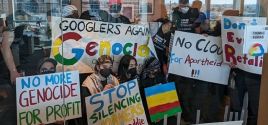FBI Pins 'Terrorist' Nametag On 'Retarded Fool' Without A 'Pot To Piss In'by Tim CushingTechdirt Mar. 18, 2015 |
Popular 
'Woke' Google Fires 28 Employees Who Protested Gaza Genocide

Report: Blinken Sitting On Staff Recommendations to Sanction Israeli Military Units Linked to Killings or Rapes

America Last: House Bill Provides $26B for Israel, $61B for Ukraine and Zero to Secure U.S. Border

Bari Weiss' Free Speech Martyr Uri Berliner Wants FBI and Police to Spy on Pro-Palestine Activists

John Hagee Cheers Israel-Iran Battle as 'Gog and Magog War,' Will Lobby Congress Not to Deescalate
 The FBI's preference for easily-investigated terrorism is well-documented. We're routinely assured that all sorts of domestic surveillance tech and agency opacity is necessary to protect us from a whole host of threats, but for the most part, the terrorists "apprehended" by the FBI seem to be people who've had the misfortune of being "befriended" by undercover agents and/or confidential informants. When over 90% of the funding, idea generation, transportation and motivation comes from those saving us from terrorism, we have reason to be worried. While the FBI performs its predatory handcrafting of "extremists," the real terrorists -- who don't need someone else to provide weapons, money and motivation -- are still going about the business of terrorism. This isn't to say that all, or even a majority, of the FBI's anti-terrorist resources are devoted to digging a hole and filling it back up. But a portion of it is, and that portion is squandered completely. And these numbers, gathered by The Intercept, put the squandered portion at nearly 50% of the total. Informant-led sting operations are central to the FBI’s counterterrorism program. Of 508 defendants prosecuted in federal terrorism-related cases in the decade after 9/11, 243 were involved with an FBI informant, while 158 were the targets of sting operations.The (supposed) terrorist in this case -- who was 25 years old when FBI agents dressed him up as a terrorist (having provided the weapons and bomb-making material) and recorded a so-called "martyrdom video" written and directed by undercover agents -- was broke and apparently unable to aspire to anything, much less a series of bombings culminating in death-by-suicide-vest. The agents referred to Sami Osmakac as a "retarded fool" without a "pot to piss in." According to The Intercept's in-depth report, Osmakac couldn't have financed his own glorious Muslim "revenge." He couldn't even afford to replace the dead battery in his '94 Honda. He had no money, no social life and no wheels. And yet, the FBI portrayed him as capable of doing the following: After recording this video in a rundown Days Inn in Tampa, Florida, Osmakac prepared to deliver what he thought was a car bomb to a popular Irish bar. According to the government, Osmakac was a dangerous, lone-wolf terrorist who would have bombed the Tampa bar, then headed to a local casino where he would have taken hostages, before finally detonating his suicide vest once police arrived.And yet, when it came down to it, the FBI had to supply everything, including a ride. The FBI provided all of the weapons seen in Osmakac’s martyrdom video. The bureau also gave Osmakac the car bomb he allegedly planned to detonate, and even money for a taxi so he could get to where the FBI needed him to go.To the government, Osmakac was a dangerous "lone wolf." To several psychiatrists and psychologists, he was a "very disturbed" young man. To the agents actually on the case, he was a joke -- a small-minded wannabe with minimal aspirations and "pipe dreams." The audio captured after the "martyrdom video" -- which was never meant for public consumption -- contains plenty of mockery from his FBI handlers. “When he was putting stuff on, he acted like he was nervous,” one of the speakers tells Amir. “He kept backing away …”Because Osmakac couldn't be counted on to follow through with the FBI's conceived plan, agents had to go on the offensive. They forced $500 into Osmakac's hands to use as a down payment on weapons. To the DOJ, the money that was hesitantly accepted was an indicator of Osmakac's willingness to kill for his ideology. But the FBI couldn't do it directly, or it would be open to claims of entrapment. Instead, it laundered it through a confidential informant -- who was also Osmakac's employer and who was paying the would-be terrorist out of his FBI paycheck. Then, the FBI helped Osmakac load up a vehicle with pretend bombs and real weapons and pounced as soon as the task was completed. To be sure, Osmakac was a disturbed man with dreams of becoming a devout Muslim in another country, but he was also professionally diagnosed with schizophrenia -- something that certainly would have made him appear unhinged and potentially dangerous. But would he have turned terrorist without the FBI's extensive help? That's a bit harder to answer, especially since the FBI kind of took a lot of the uncertainty out of the equation. Rather than simply surveil a possible threat, it stepped in to push him in a direction he'd only talked about -- and even then, in mostly delusional terms. But this is what passes for "investigation" with the FBI: sting operations, overactive informants and undercover agents, and no small amount of self-congratulatory backpatting when all the work is done. |



